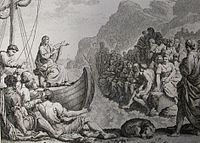
This narrative is told in Matthew 13:1-3, Mark 4:1, and Luke 5:1-3. Owing to the vast crowds that followed him from the surrounding towns and villages to listen to his doctrine, Jesus retired to the sea coast. There he entered a boat, that he used as a pulpit, and addressed the crowd on the shore.
The narrative occurs as an introduction to a set of Jesus' parable teachings, which starts with the Parable of the Sower.
Numerous artists have made this event the subject of their artwork, including, James Tissot and Alexandre Bida.
Narrative
Lukian version
And it came to pass, that, as the people pressed upon him to hear the word of God, he stood by the lake of Gennesaret, And saw two ships standing by the lake: but the fishermen were gone out of them, and were washing their nets. And he entered into one of the ships, which was Simon's, and prayed him that he would thrust out a little from the land. And he sat down, and taught the people out of the ship.
— Luke 5:1-3, New International Version
Commentary
4th-century
Hilary of Poitiers comments on why Jesus sat in the ship, while the crowd remained on the shore, writing, "for He was about to speak in parables, and by this action signifies that they who were without the Church could have no understanding of the Divine Word. The ship offers a type of the Church, within which the word of life is placed, and is preached to those without, and who as being barren sand cannot understand it."
17th-century

Cornelius a Lapide notes that when Jesus, as was his custom, had finished preaching in His house in Capernaum, He sent away the crowd so they might attend to themselves, and that He should allow some rest and food for Himself and His disciples. However, since He knew that the crowds were about to come to Him in such numbers that His house could not accommodate them, He left to the wide, open shore of the Sea of Galilee. There he used a boat as a pulpit and preached to the crowd on the shore.
19th-century (Catholic)
John McEvilly comments on the words “many things,” (Matt 13:3) writing, "most likely, He spoke much more than is here recorded. For, if every thing which Jesus did, was written, “the world itself would not be able to contain the books that should be written”" (John 21:25).
A number of commentators have used this episode to support the primacy of Peter, since Jesus uses Peter's boat to preach from, and Peter would later become the foremost disciple among the apostles for preaching himself (see Acts 2).
Gallery of art
- Depictions of Jesus preaching from a ship
-
 A print from the Phillip Medhurst Collection of Bible illustrations (Dutch Bible)
A print from the Phillip Medhurst Collection of Bible illustrations (Dutch Bible)
-
 Preaching from a ship. French School. In the Bowyer Bible in Bolton Museum
Preaching from a ship. French School. In the Bowyer Bible in Bolton Museum
-
 Jesus preaching from a boat near shore. W. J. Morgan (1890)
Jesus preaching from a boat near shore. W. J. Morgan (1890)
-
 Extensive landscape with Christ standing on a fishing boat (1600-1700)
Extensive landscape with Christ standing on a fishing boat (1600-1700)
-
 Pencil, pen and black ink, watercolour and bodycolour painting by J. Smetham.
Pencil, pen and black ink, watercolour and bodycolour painting by J. Smetham.
-
 Jan Brueghel the Elder, The Sermon on the Sea of Galilee, 1597
Jan Brueghel the Elder, The Sermon on the Sea of Galilee, 1597
See also
- Life of Jesus in the New Testament
- Ministry of Jesus
- Calling of the disciples
- Parables of Jesus
- Miraculous catch of fish
- Sea of Galilee Boat
References
- Matthew 13:1–3
- Luke 5:1–3
-
 This article incorporates text from this source, which is in the public domain: "Catena aurea: commentary on the four Gospels, collected out of the works of the Fathers: Volume 6, St. John. Oxford: Parker, 1874. Thomas Aquinas". 1874.
This article incorporates text from this source, which is in the public domain: "Catena aurea: commentary on the four Gospels, collected out of the works of the Fathers: Volume 6, St. John. Oxford: Parker, 1874. Thomas Aquinas". 1874.
-
 This article incorporates text from this source, which is in the public domain: Lapide, Cornelius (1889). The great commentary of Cornelius à Lapide. Translated by Thomas Wimberly Mossman. London.
This article incorporates text from this source, which is in the public domain: Lapide, Cornelius (1889). The great commentary of Cornelius à Lapide. Translated by Thomas Wimberly Mossman. London.{{cite book}}: CS1 maint: location missing publisher (link) - MacEvilly, Rev. John (1898). An Exposition of the Gospels. New York: Benziger Brothers.
- Knecht, Friedrich Justus (1910). A Practical Commentary on Holy Scripture . B. Herder.
| Jesus | |
|---|---|
| Chronology of Jesus's life |
|
| New Testament | |
| Historicity | |
| Depictions | |
| Christianity | |
| In other faiths | |
| Family |
|
| Related | |